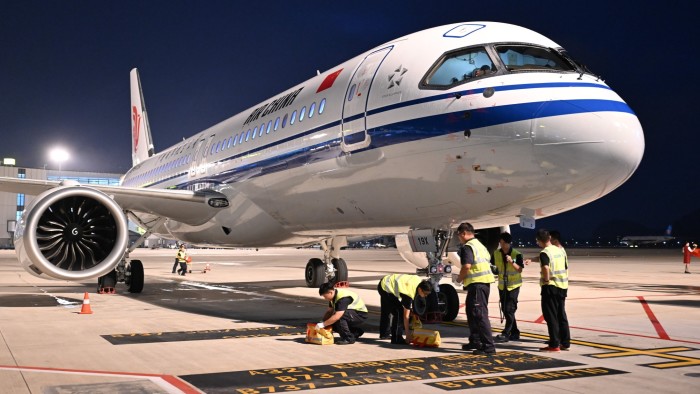China is stepping up its push to break Boeing and Airbus’ stranglehold on the aircraft market, as the state-owned manufacturer of the country’s first passenger jet seeks certifications for it to fly beyond the country’s shores.
Comac’s heavily subsidized C919 aircraft, which made its first commercial flight in 2023, is already flown on domestic routes by China’s big three state carriers: Air China, China Eastern Airlines and China Southern Airlines. From this month, China Eastern will fly the C919 between Hong Kong and Shanghai, the first regular commercial route outside China.
Yang Yang, the company’s deputy general manager of marketing and sales, told the Financial Times that the company aimed to have the single-aisle aircraft flying in Southeast Asia by 2026 and gain European certification as early as this year.
“We hope to operate more aircraft domestically in China and fully identify any problems beforehand. . . bringing them to Southeast Asia,” he said.
The C919 is a key project in President Xi Jinping’s efforts to move China up the technology value chain, with the ultimate goal of challenging the Western duopoly of Boeing and Airbus.
Boeing’s financial woes and delivery delays, as well as broader industry supply chain woes that have left it and Airbus facing engine and component shortages, have weighed on the global aviation sector and offered hope for entrants .
The world will need 42,430 new planes over the next two decades, roughly 80 percent of which will be single-aisle planes, according to an Airbus forecast in 2024. Aviation consultancy IBA predicts Comac could increase production of its C919s – 16 of which have been delivered to Chinese airlines since December – from one to 11 per month through the year 2040, by which time it can deliver almost 2,000 units of the aircraft.
However, Jonathan McDonald, the IBA’s manager of classic and cargo aircraft, said that while Comac would eventually break into export markets, “for the foreseeable future Airbus and Boeing will be the main suppliers of narrowbodies to most airlines “.
Global certification and maintenance support remain significant obstacles to Comac’s ambition for the C919 to operate overseas.
In a move to increase its international presence, Comac opened new overseas posts in Singapore and Hong Kong in October.
The new offices were needed to help take orders for new aircraft from customers, according to Mayur Patel, head of Asia for OAG Aviation.
But Richard Aboulafia, managing director of AeroDynamic Advisory, said building “elaborate product support facilities in export markets is very difficult and expensive work and a necessary prerequisite to compete with Airbus and Boeing”.
While several carriers in Asia have expressed interest in the C919, some executives privately say they remain undecided.
“Maintenance support is the main issue,” said a person close to Indonesia’s TransNusa, which has already taken delivery of three of Comac’s smaller ARJ21 planes and is considering flying the C919.
The path for Comac to gain overseas certification, particularly from the European Union’s Aviation Safety Agency, is also challenging, according to analysts.
“IBA does not expect the C919 to be certified in Europe in the near future,” McDonald said. “Europe has very strict certification parameters.”
Meanwhile, certification by the US Federal Aviation Authority is likely to be complicated by US-China tensions.
EU and US regulators are often the “gold standard” for other global authorities, according to David Yu, an aviation industry expert at NYU Shanghai.
In parallel with its C919 push, Comac is also developing its first wide-body aircraft, the C929. At one of China’s biggest air shows in Zhuhai in November, the company announced that state-owned Air China had become the first airline to commit to flying the jet, which aims to challenge the largest planes made by Airbus and Boeing as the 787 Dreamliner.
Sash Tusa, a UK-based aerospace and defense analyst, said that while the C929 offered China another opportunity to prove its technological advancement in the aerospace sector, the country would probably still be dependent on engines overseas for commercial aircraft. IBA estimates that the C929 will not enter service before 2040.
For the C919, the main components are still of Western manufacture. The aircraft’s engines are supplied by Franco-American venture CFM International while its auxiliary power units are manufactured by US-based Honeywell.
“So far, (Comac) is building aircraft that are mostly Western in value but with Chinese structures,” said Aboulafia of AeroDynamic Advisory. “This makes production ramps dependent on the West’s willingness to continue securing the systems and, given a Trump presidency, there is no guarantee of that at all.”
Comac probably won’t be able to take any “fair share of the global market” within the next decade, Tusa said, but it will provide a “significant import substitution” for domestic Chinese airlines.
“Airbus is built in China. Boeing doesn’t,” he said. “So, Comac comes as the second supplier. Import substitution does not make you a competitor. That makes you an act of state policy.”
Additional reporting by William Langley in Guangzhou


